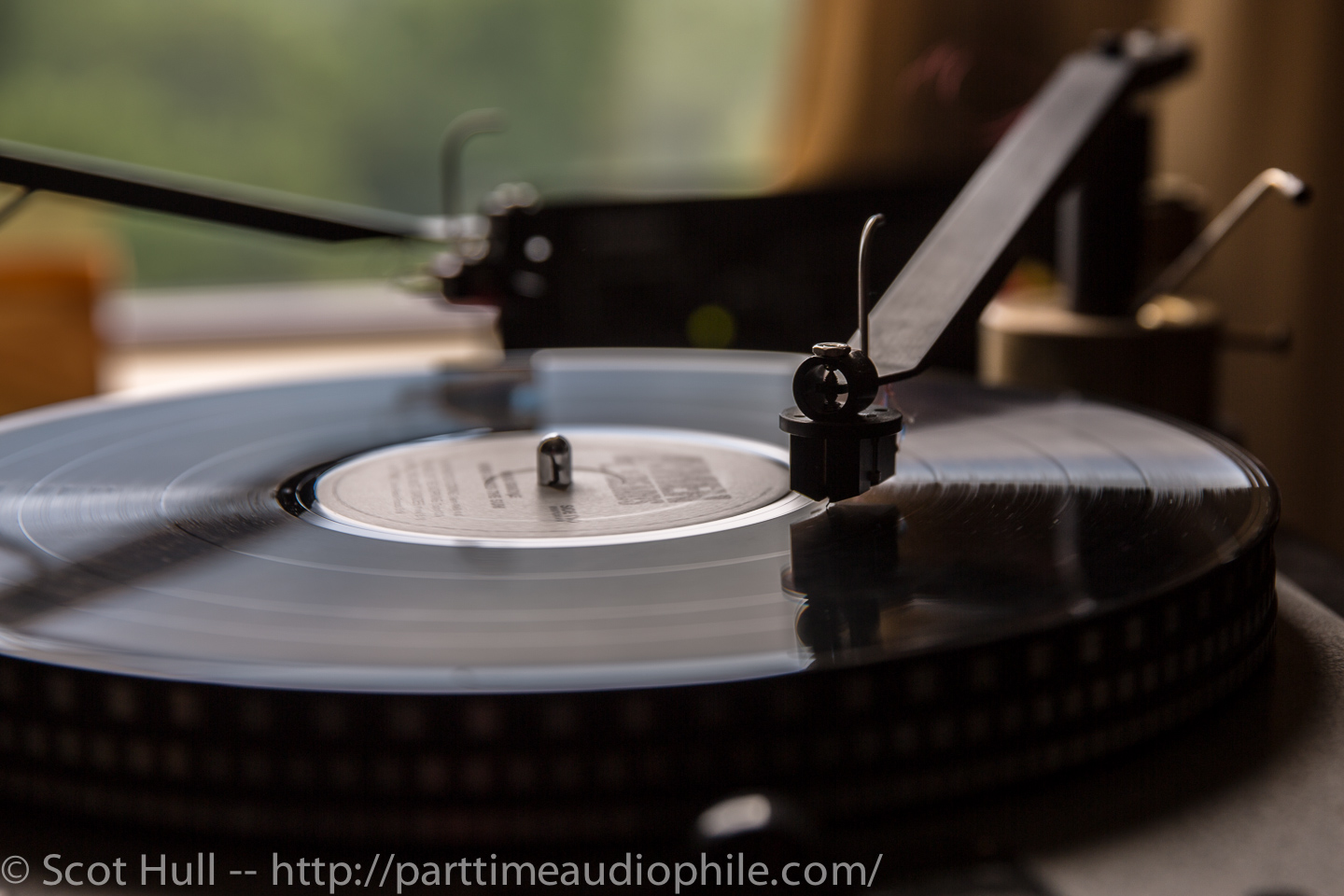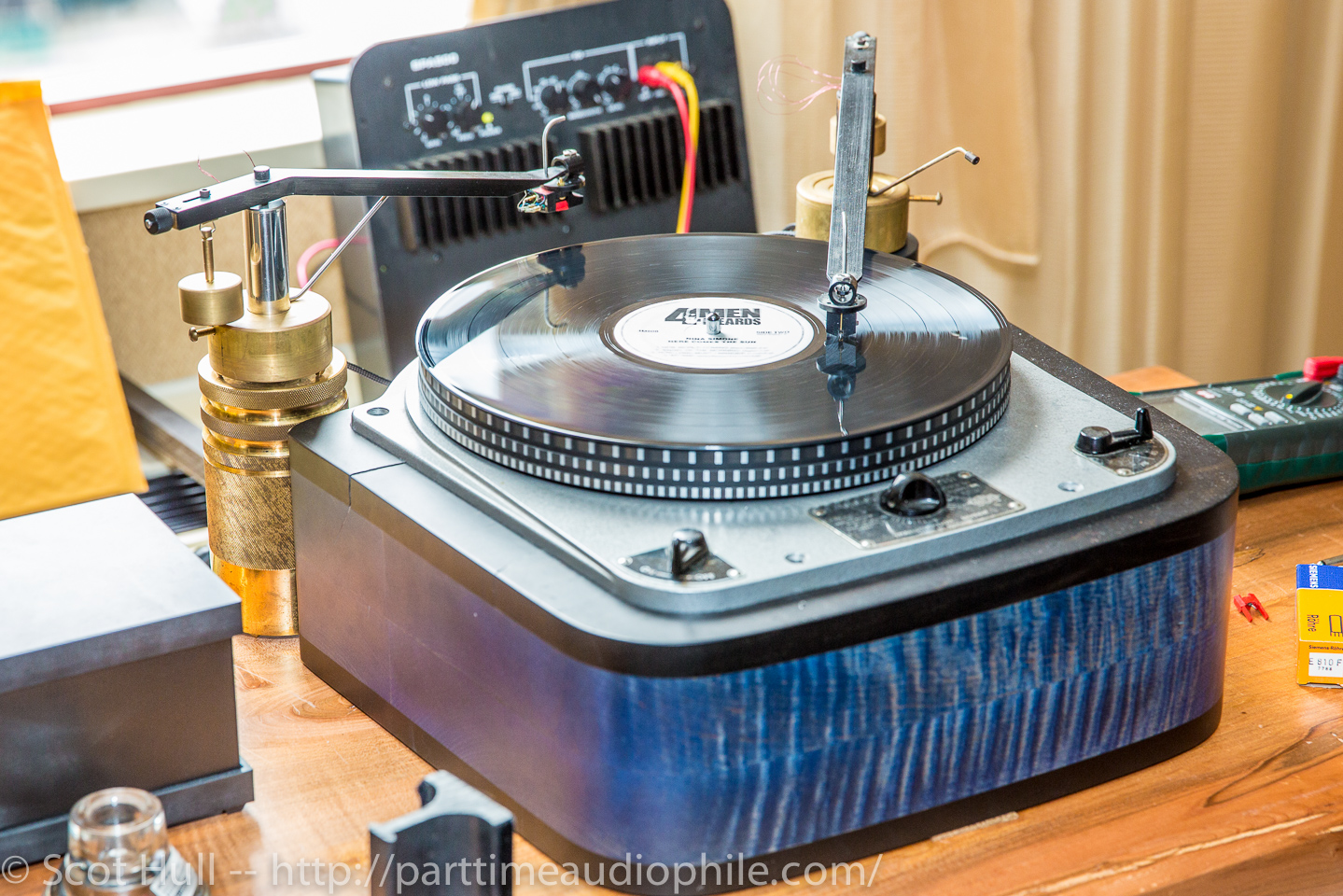 One of the most visually striking demos I caught at CAF this year was from show-organizer Gary Gill and his Sousahorn display. The Sousahorn is derived from the Le Ceac’h exponential horn designs, currently sold under the brand names of Azura or Oris — essentially, it’s a honkin’ big horn, a component in a DIY loudspeaker design.
One of the most visually striking demos I caught at CAF this year was from show-organizer Gary Gill and his Sousahorn display. The Sousahorn is derived from the Le Ceac’h exponential horn designs, currently sold under the brand names of Azura or Oris — essentially, it’s a honkin’ big horn, a component in a DIY loudspeaker design.
Gary, who manufactures and sells the Sousahorn locally, says there are two sizes available, both with a 7″ “throat opening”, large enough to suit a Lowther, Tang Band and many more full-range drivers. Price for the 34″ diameter horn is $750; the 40″ diameter is $950.
Shown here with some bass cabinets that Gary made to show off the horns, the resulting speaker shown was a large, high-sensitivity three-way with a Tang Band shoved deep into the horn, with tweeters dangling off the audio rack. The whole thing was tri-amped using electronics from Emia and LM Audio and wired up with cables from Triode Wire Labs.
Emia’s Dave Slagle was running the room and taking requests. On an iPhone. In the hall. Jammed into a vintage horn. No, seriously. Dave was in the hall way, brandishing a beat up horn with a foam block he set on the end, with a small slot you could jam an iPhone into. Which he had. Guess what? Damn thing worked, too. And not too shabby, either. But this was the mood in the Sousahorn room — merry. And once inside, the sound field was huge and immersive and dynamic like nothing else at the show. In the spirit of full disclosure, the sound was a bit erratic on Day One, but had largely settled out by Day Two with the impromptu conversion of the speaker systems from a two-way into a three-way. I’m pretty sure there’s a whole story there. Whatever. What it was, was fun, and the energy in the room carried away minor concerns.
As I mentioned, the electronics were mostly sourced from Emia. If you’re looking for bespoke, hand-made audio jewelry with a clear heirloom chic, you’ve found a haven. Dave and Jeffrey Jackson are well-known (for Dave at least, seemingly uncomfortably so, something you’ll catch quick by watching him squirm when someone says anything approaching admiration within his earshot) for their custom-wound transformer-based electronic components, but their finished products are just incredible.
In the rack, a refurbished Garrard 301 turntable mounted with a RS Labs RS-A1 tonearm and a Denon DL-103R cartridge,was wired to an Emia Silver SUT ($3,600), in turn connected to an Emia phono pre ($5,400), and from there to the sonically invisible autoformer-based Remote Attenuator (Silver = $5,400), and on to a pair of Permalloy 50 microwatt monoblock amps ($15,000/pair). Oh, and there were a pair of tweeters in there, too.
What? Where do you hang yours?
More superficially, I’ll note that I’ve been a big fan of Emia’s “drug-through-the-Hudson aesthetic” (Dave’s words), and seeing the full kit here on display was a great opportunity for photojournalistic excess, so naturally I indulged.
More details about the Emia product line can be found on their website and you can contact Gary Gill directly at Capital Audiofest for details and availability on the Sousahorn.



























I have heard this system powered by a vintage fisher 12 watt amp and it was great. Yes it’s big and needs its own man cave but you do not need the high price electronics to drive it to extremely satisfying sound. Once this speaker is finalized it will be quite a bargain!
At least when I was there the drivers in the horns were Tang Band. Looks like that’s what’s in your photos as well…
Roscoe
Whoops. Noted and corrected ….
Ah yes, merriment and fun. That’s what it’s all about. Forget the minor concerns! What does the whole thing cost? Just $30,000 for the stuff in the rack? That’s nothing!
I usually just delete trolling posts, but I think it’s worth taking a moment to say, yes, that is what it’s all about. This is obviously not a full-time, dedicated career for the vast majority of any of the attendees — it’s a hobby. And if your hobby isn’t fun, why do it? I mean, really. Why?
I say this because I think way too many folks lose track. Yes, “great sound” is a “noble goal” — but it’s not important. I’d argue that it’s never important, but that’s beside the point. The point here is about sharing. That’s why we go to an audio show, instead of just reading about one online or hanging out in your parent’s basement all day fussing over the placement of your footers. We go to share. To talk. To learn. And, heaven forbid, to have fun.
As for the “stuff in the rack”, that “stuff” is some of the most bespoke gear you can find anywhere, much less actually purchase. That “stuff” is all one-of-a-kind hand-crafted art rendered by masters. And this is the part where you get whacked in the back of the head with a rolled up newspaper.
Look, you don’t have to like it. No one said you have to be able to afford it. But when you see a Jackson Pollock hanging at the Met, the only valid reaction is respect. Snark, because that painting happens to be
not for salepricey, is petulant and stupid. Seriously. Grow up.+1 Scot!
Haters going to hate… Appreciate you keeping it real (and fun!). Your blog puts a smile on my face every day… Love to see how diverse our hobby is, how much there is to learn and be inspired by others. Fly your Freak Flag high brothers and sisters!
Thanks, John! I’m actually gonna be out your way next week to meet with Mark. We should catch up!
WAF gotta be way, way underwater…butt ugly is an understatement
The boxes for the subs need some work, otherwise, I’m good. Assuming it sounds as good as Scot says, of course — that’s the main source of WAF from me. 🙂